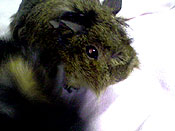
Pets are a wonderful source of happiness and inspiration.
Educators have used animals in the classroom for decades. From a goldfish filled aquarium to the hamster who roams the classroom floor in his roller ball, there is no doubt that critters are a great educational tool. However, keeping a classroom pet takes a lot of time and effort. There is more involved than simply purchasing a small cage and a bag or two of food. There are a lot of factors to consider before taking the plunge. Here are a few of the pros and cons of having a critter in the classroom.
PROS
- An animal in the classroom creates improved learning experiences for your students as all areas of the curriculum are enhanced. EG: Math (how much does a hamster weigh?) Science (what does a snake eat?) Geography (where does a ferret come from?) Social Studies (different cultures - different pets) and Language Arts (how can I describe the goldfish?)
- Students can easily see, feel, touch and make connections to the wide world of animals.
- Observing and caring for an animal instills a sense of responsibility and respect for life.
- Enthusiastic participation on the part of your students.
- Increased sensitivity and awareness of the feelings and needs of others --- both animals and humans.
- There will be an understanding that all living things need more than just food and water for survival.
- Students will see how their behavior and actions affect others.
- Less tension in the classroom.
- Other classrooms can visit the classroom pets and students can create presentations for them.
- Animals need food, water and most of all attention. Some, obviously more than others. You should be prepared to provide all of these things on a regular basis.
- Its not enough to send students home with pets for weekends and holidays. Parent MUST be involved.
- Your classroom must be suitable for the animal you choose to keep. Snakes, hamsters and rabbits all need a certain environment to be healthy. All it takes is a little research and homework to see if your classroom is pet-friendly.
- Certain animals need room to roam. Can you provide this?
- You must stick to the animal's diet. Bits of sandwiches and candy bars are not acceptable.
- If you have a male and female hamster, rabbit or fish are you prepared for babies? Will you spay or neuter your larger pets?
- If the pet becomes ill, are you able to care for it? Do you have a vet?
- Do you have students with severe allergies? Choose a pet that won't cause problems.
If you are thinking of adding a pet to your classroom, please don't feel discouraged. Simply put, a pet is a big responsibility and you should always think before you act. As a teacher, the animal will become your responsibility and you should be fully prepared. Do you know any teachers who have pets in their classroom? Talk to them, they will be a great resource as you decide to bring a critter into your classroom. Of course, there is always the option of keeping a "virtual" pet. This could be a pet on the internet or a pet that you and your students create.
Still interested? The key is to choose a pet that you can safely and comfortably keep in your classroom. If that means one goldfish in a bowl, well than go out and find yourself a goldfish and call him Charlie. Why not?
Here are the most popular classroom pets:
- turtles
- frogs
- hamsters
- gerbils
- guinea pigs
- rabbits
- spiders
- rats
- parrots
- crabs
- guppies
- goldfish
- lizards
- snakes
